North Padre Island is a beautiful and expansive barrier island located off the coast of Texas. It is home to a diverse range of wildlife, including an impressive array of bird species.
These birds inhabit the island’s coastal habitats, such as marshes, dunes, and beaches. Each year, thousands of birds migrate to North Padre Island, making it an important stopover location for many species.
Whether you are a bird enthusiast or a nature lover, the birdlife of North Padre Island is a sight to behold. In this article, we will delve deeper into the different bird species found in North Padre Island, their habitats and behaviors, and their contribution to the island’s ecosystem.
1. Northern Mockingbird
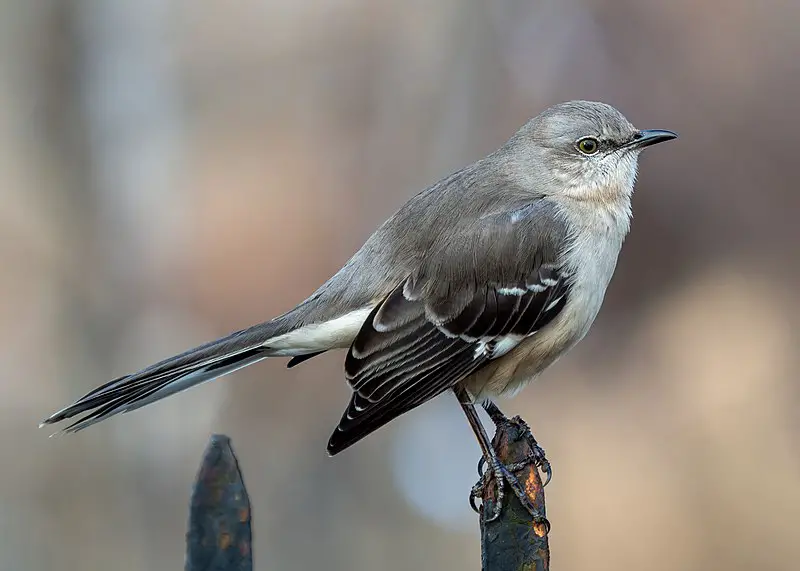
The northern mockingbird is a common fixture in North American skies. It has greyish-brown upperparts and a paler underside with white wing patches, and its distinctive long tail makes it easy to spot.
This adaptable bird can often be seen singing from the tops of trees or fences, though it rarely strays into Europe.
The species was first described by Carl Linnaeus in his 1758 Systema Naturae as Turdus polyglottos – aptly named for their remarkable ability to mimic other birds’ songs.
Northern mockingbirds typically live on insects, fruits, berries and seeds but they will also happily scavenge food scraps left out by humans.
With its beautiful song and striking plumage this beloved avian makes an important contribution to our environment.Scientific classification:
| Kingdom | Animalia |
| Phylum | Chordata |
| Class | Aves |
| Order | Passeriformes |
| Family | Mimidae |
| Genus | Mimus |
| Species | M. polyglottos |
Also Featured In: Most Common United States Birds, Most Common Winter Birds
2. American Coot
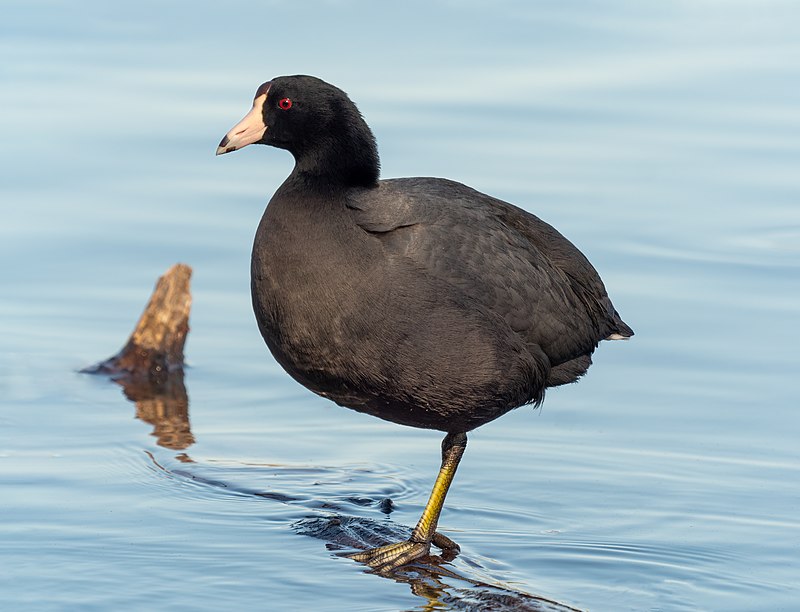
The American coot is a bird of the Rallidae family, commonly mistaken for ducks. However, they are only distantly related and have broad lobed scales on their lower legs and toes that fold back with each step to help them walk on dry land unlike ducks which have webbed feet.
Coots are omnivores who typically live in freshwater marshes, ponds and lakes but can also be found in brackish water habitats or even open oceans during migration season.
They feed mainly on algae and aquatic plants as well as small fish, snails, insects larvae and worms from time to time.
The males display territorial behaviour by chasing away intruders within their territory while females lay eggs mostly.
In floating nests made of vegetation near shorelines or islands among reeds where chicks hatch after about three weeks incubation period before swimming off into adulthood shortly afterwards at 10-12 weeks old.Scientific classification:
| Kingdom | Animalia |
| Phylum | Chordata |
| Class | Aves |
| Order | Gruiformes |
| Family | Rallidae |
| Genus | Fulica |
| Species | F. americana |
Also Featured In: Most Popular Bird Species in North America, Phoenix Birds You Should Know
3. Belted Kingfisher
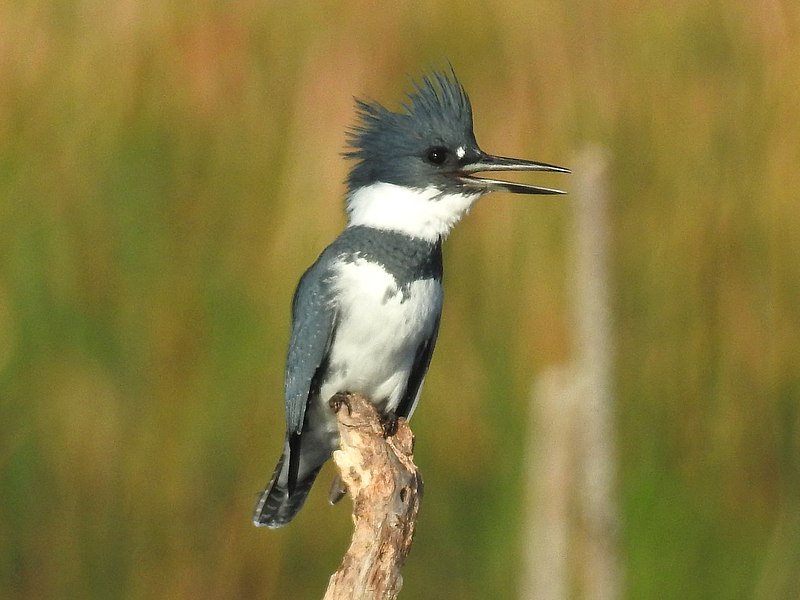
The belted kingfisher is a large, eye-catching bird native to North America. It belongs to the family Alcedinidae and has been divided into three subfamilies by recent research.
The species was first described in 1758 by Carl Linnaeus in his Systema Naturae.
This water Kingfisher stands out for its size as well as its striking plumage; males are bright blue on top with white below and females have rusty brown backs and wings with a thick black breast band across their chest.
They also possess an impressive call which can be heard from quite far away.
Belted kingfishers feed mainly on small fish but will sometimes also eat crustaceans, insects or even amphibians if they come across them while hunting around rivers or streams.
All in all, this is truly one remarkable bird that deserves our admiration.Scientific classification:
| Kingdom | Animalia |
| Phylum | Chordata |
| Class | Aves |
| Order | Coraciiformes |
| Family | Alcedinidae |
| Subfamily | Cerylinae |
| Genus | Megaceryle |
| Species | M. alcyon |
Also Featured In: Birds That Live in Colorado, Blue Birds You’ll Found around Us
4. American White Pelican
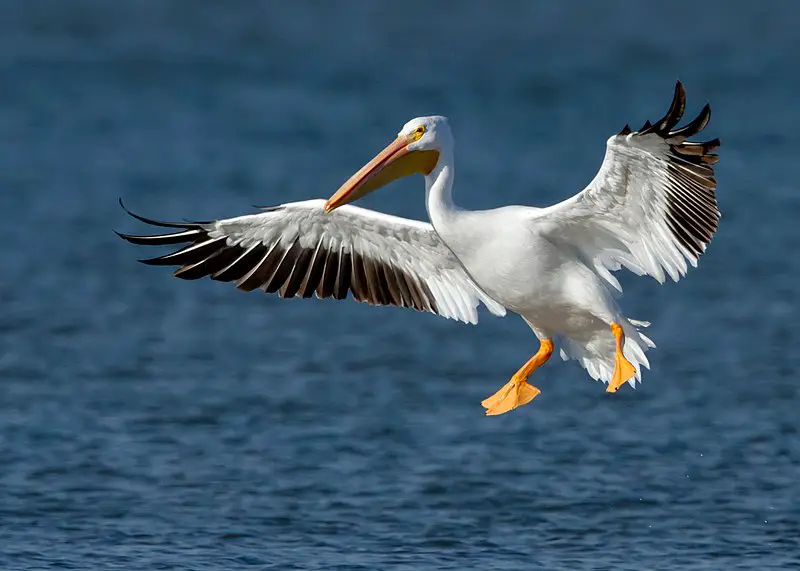
The American White Pelican is a majestic bird from the Pelecaniformes order, known for its impressive size and ability to soar gracefully in the sky.
It breeds during summer months in North America and migrates southwards towards Central and South America during winter.
The species was first described by German naturalist Johann Friedrich Gmelin back in 1789 as part of his updated version of Carl Linnaeus’ work.
This large aquatic bird has an all-white plumage with black primary flight feathers on its wings, while its beak features a characteristic yellowish colouration at the base near the face.
Its diet mainly consists of fish which it typically catches after dipping into water using its long bill; yet sometimes they can be seen stealing food items from other birds such as cormorants or gulls.Scientific classification:
| Kingdom | Animalia |
| Phylum | Chordata |
| Class | Aves |
| Order | Pelecaniformes |
| Family | Pelecanidae |
| Genus | Pelecanus |
| Species | P. erythrorhynchos |
Also Featured In: Birds Live in Arkansas, Birds You’ll Find in South Texas
5. Yellow-Rumped Warbler

The Yellow-rumped Warbler (Setophaga coronata) is a migratory bird species that can be found throughout North America.
It has an extensive range, from the Pacific and Atlantic coats of the US to Canada and Central America, with a concentration in northern areas during breeding season.
These birds migrate southwards for wintering grounds where they find plentiful food sources such as insects and berries.
They are easily identified by their yellow patches on either side of their tails, along with white underparts, gray back feathers and two distinct crown stripes.
One black or greyish-brown above the eyes extending towards its neck banded in yellow or light brown colouration.
Furthermore, these warblers have strong legs which allow them to cling onto branches while hunting for prey making them adept at maneuvering through tree cover quickly.
All together this makes the Yellow-rumped Warbler an attractive backyard visitor year round.Scientific classification:
| Kingdom | Animalia |
| Phylum | Chordata |
| Class | Aves |
| Order | Passeriformes |
| Family | Parulidae |
| Genus | Setophaga |
| Species | S. coronata |
Also Featured In: Birds Live Near San Diego, New Hampshire Birds You Should Know
6. Great-Tailed Grackle
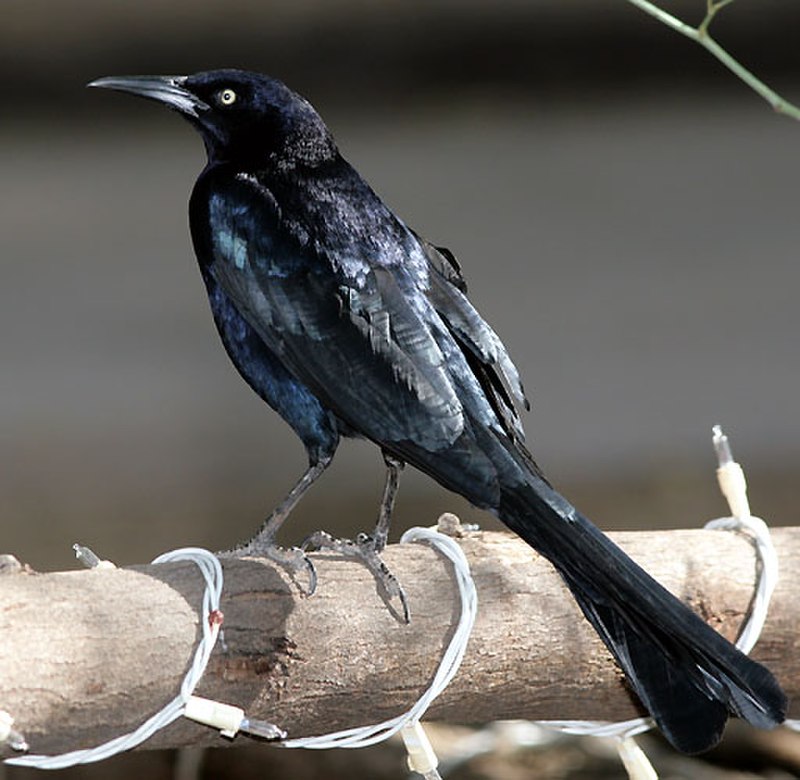
The Great-tailed Grackle is a medium sized bird native to North and South America. It belongs to the family Icteridae, making it closely related to two other species of grackles – the Boat-tailed and Slender-billed.
They are highly social birds which often appear in large flocks or colonies.
Their plumage ranges from glossy black with blue or purple iridescence, through brownish grey shades depending on location.
In some areas they have been known as “blackbirds” due their predominately dark colouring.
This adaptable species is also renowned for its distinctive long tail feathers – hence its name.Scientific classification:
| Kingdom | Animalia |
| Phylum | Chordata |
| Class | Aves |
| Order | Passeriformes |
| Family | Icteridae |
| Genus | Quiscalus |
| Species | Q. mexicanus |
Also Featured In: Top Birds Found in Mexico, Common Birds That Live in Las Vegas
7. American White Ibis
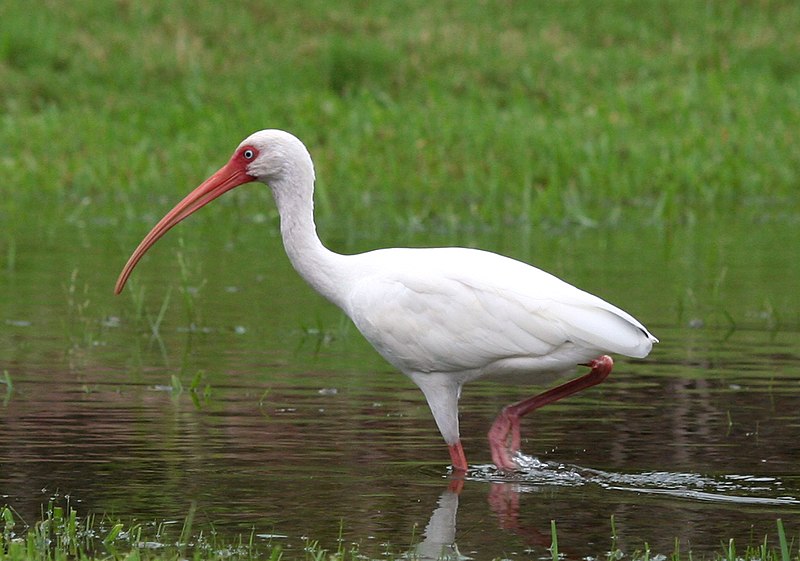
The American white ibis is a medium-sized bird with an overall white plumage and long legs. It has a bright red-orange downward curved bill, and black wing tips that are usually only visible in flight.
This species of ibis can be found from Virginia south through most of the coastal New World tropics.
They have been known to inhabit marshes, swamps, ponds, lakeshores as well as mangrove forests near water sources where they feed on crustaceans such as crabs and shrimp among other aquatic animals like insects or snails.
The American white ibis plays an important role in its ecosystem by helping to control insect populations which helps maintain balance within these environments.Scientific classification:
| Kingdom | Animalia |
| Phylum | Chordata |
| Class | Aves |
| Order | Pelecaniformes |
| Family | Threskiornithidae |
| Genus | Eudocimus |
| Species | E. albus |
Also Featured In: Everglades Birds, Swamps Birds You Should Know
8. Reddish Egret
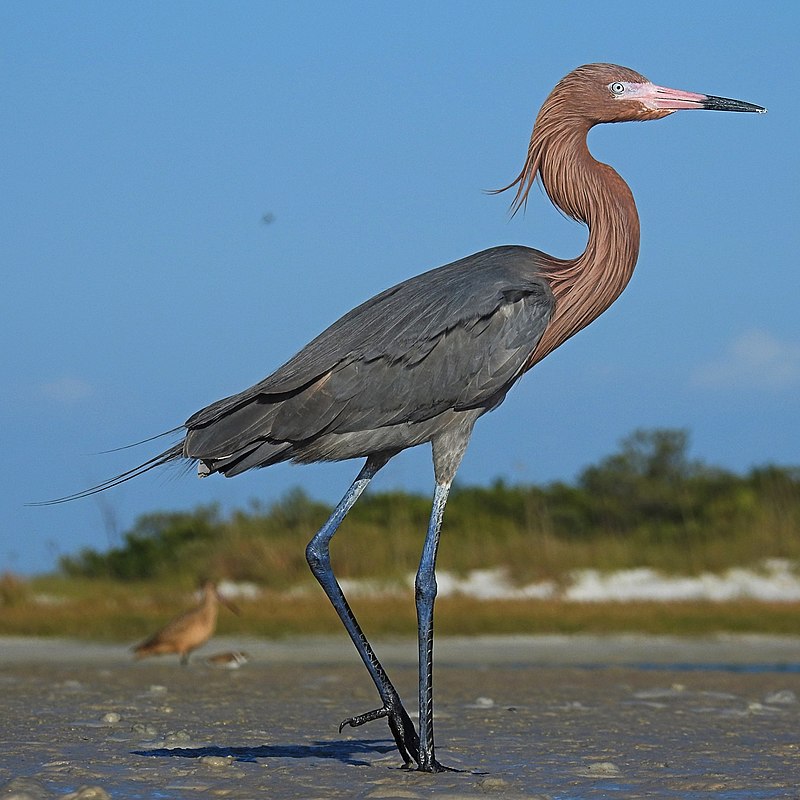
The Reddish Egret is a medium-sized heron that breeds in Central America, The Bahamas, the Caribbean, Texas and Mexico.
It prefers mud flats as its habitat of choice due to its unique foraging behaviour which differs from other herons.
In the past it was hunted widely for its feathers used to make fashionable hats but thankfully this practice has now been stopped.
They have white or grey plumage with pink legs and bill giving them their name.
These birds feed mainly on fish which they catch by making quick darting movements in shallow water or running rapidly through shallows stirring up prey so they can snatch them easily with their bills.
Their long wings enable them to fly quickly when hunting and also during migration season when many travel southwards towards warmer climates.Scientific classification:
| Kingdom | Animalia |
| Phylum | Chordata |
| Class | Aves |
| Order | Pelecaniformes |
| Family | Ardeidae |
| Genus | Egretta |
| Species | E. rufescens |
Also Featured In: Birds that Live around Southwest Florida, Birds You’ll Find in the Rio Grande Valley
9. Great Egret

The Great Egret is a large, white bird found in many regions of the world. It has four subspecies that reside across Asia, Africa, Americas and southern Europe.
This species usually lives near bodies of water such as lakes and marshes. They are also now starting to spread into more northern areas of Europe due to climate change.
These birds have long yellow legs with an impressive wingspan for their size which allows them to soar majestically through the sky hunting for fish or amphibians in shallow waters below.
Their feathers have been used historically by Native Americans as part of traditional garments or ceremonies but this practice should be avoided today so these amazing creatures can thrive without harm from humans.Scientific classification:
| Kingdom | Animalia |
| Phylum | Chordata |
| Class | Aves |
| Order | Pelecaniformes |
| Family | Ardeidae |
| Genus | Ardea |
| Species | A. alba |
Also Featured In: Most common Birds in France, Most Common Romanian Birds
10. Great Blue Heron

The Great Blue Heron is a majestic wading bird found in many parts of North America, Central America, the Caribbean and even as far away as the Galapagos Islands.
It has an impressive wingspan which can reach up to six feet wide. Its feathers are mainly bluish-gray with brownish streaks on both its neck and chest while its head displays white plumes.
The adult herons can also be identified by their yellow bill and legs.
They live near bodies of water such as lakes, marshes or rivers where they feed on fish using a spear like motion with their sharp bills.
An all-white population exists only in south Florida and the Florida Keys making it quite unique.Scientific classification:
| Kingdom | Animalia |
| Phylum | Chordata |
| Class | Aves |
| Order | Pelecaniformes |
| Family | Ardeidae |
| Genus | Ardea |
| Species | A. herodias |
Also Featured In: Common Birds in Canada, Birds Commonly Found in New York
11. Piping Plover
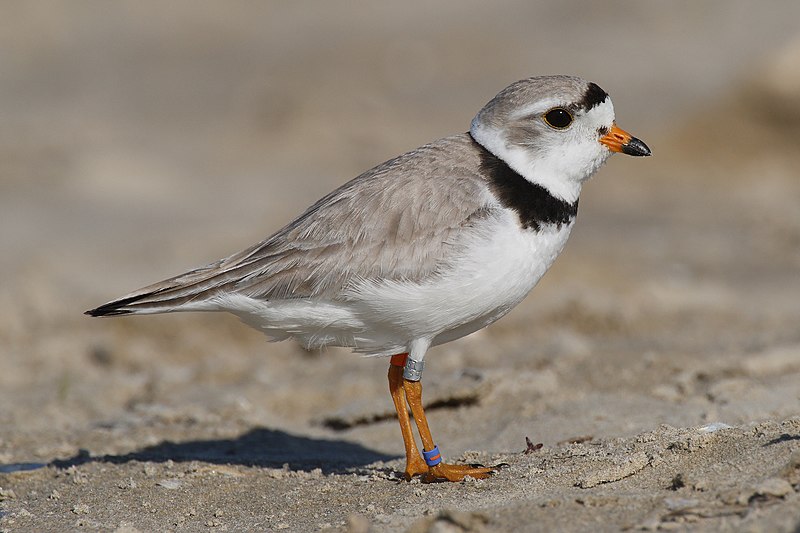
The Piping Plover is a small shorebird that can be found along sandy or gravel beaches in North America.
It has yellow-orange-red legs and its distinctive features include a black band across the forehead from eye to eye, as well as a thicker chest band for males during breeding season.
They are threatened by human activity on their habitats such as increasing development of coastal areas, destruction of their nesting sites due to recreation activities like beach driving and off-leash dogs.
Conservation efforts aim at protecting these birds through habitat protection measures including fencing off areas where they nest and restricting access during breeding seasons.
The future looks brighter with conservation initiatives by local governments slowly bringing the population up again over time.Scientific classification:
| Kingdom | Animalia |
| Phylum | Chordata |
| Class | Aves |
| Order | Charadriiformes |
| Family | Charadriidae |
| Genus | Charadrius |
| Species | C. melodus |
Also Featured In: Long Island Birds You Should Know, Summer Birds that Live around Us
12. Black Skimmer
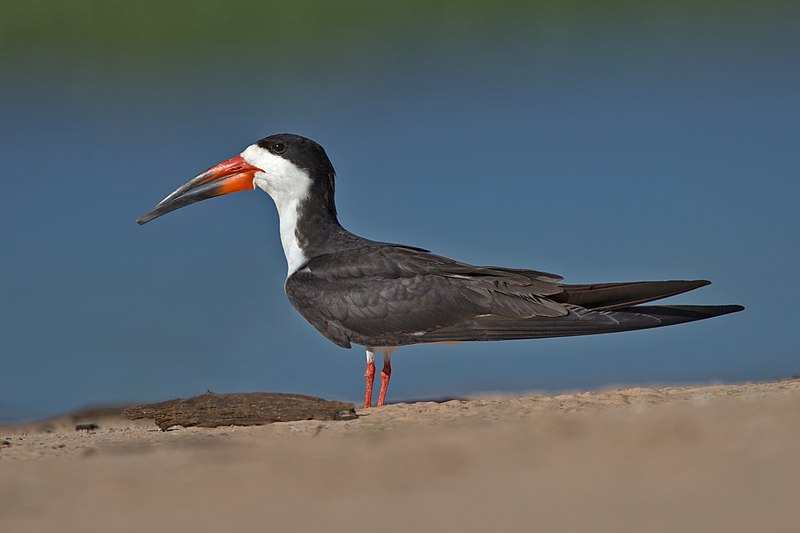
The Black Skimmer is a seabird which belongs to the skimmer genus Rynchops and Laridae family.
It breeds in North and South America, while Northern populations migrate south for winter towards warmer climates such as the Caribbean or Pacific coasts.
The Southern American races have adapted to annual floods by making shorter migrations during this time.
These birds are easily identified with their unique long red bill that has an upper mandible longer than its lower mandible.
They feed mainly on small fish caught at night when they skim across shallow water using their beak like a knife cutting through waves of water.
Their dark grey back contrasts against white belly feathers creating beautiful patterns in flight, aiding them in catching prey easier due to its camoflauge effect above and below waters surface.Scientific classification:
| Kingdom | Animalia |
| Phylum | Chordata |
| Class | Aves |
| Order | Charadriiformes |
| Family | Laridae |
| Genus | Rynchops |
| Species | R. niger |
Also Featured In: Most Unique Birds in Peru, Black And White Birds You Don’t Know About
13. Green Kingfisher
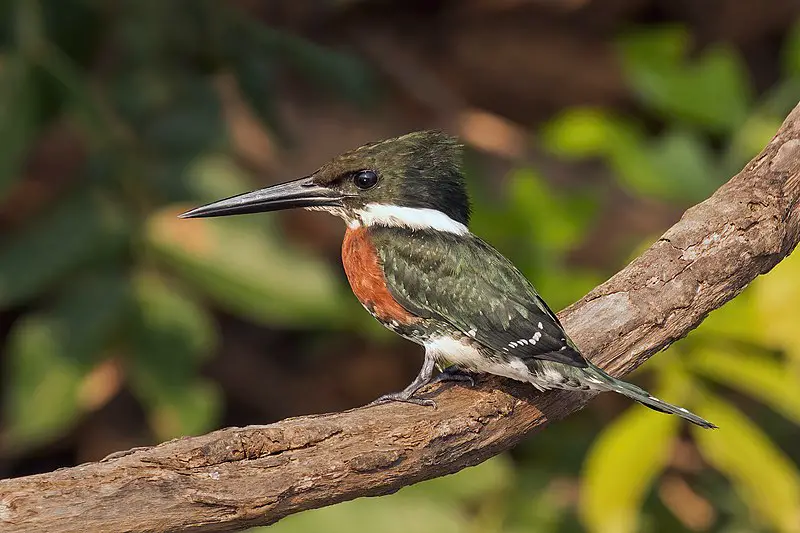
The Green Kingfisher is an incredibly vibrant bird, boasting a bright green plumage and long beak.
It can primarily be found throughout Central America, in most South American countries except Chile, as well as Texas in the United States and Trinidad & Tobago.
This species of water kingfisher belongs to subfamily Cerylinaeof family Alcedinidae which was first described by German naturalist Johann Friedrich Gmeiner back in 1788.
The Green Kingfishers are known for their active hunting habits where they perch above shallow waters looking out for prey such as small fish or crustaceans before diving down rapidly into the water with a loud splash.Scientific classification:
| Kingdom | Animalia |
| Phylum | Chordata |
| Class | Aves |
| Order | Coraciiformes |
| Family | Alcedinidae |
| Subfamily | Cerylinae |
| Genus | Chloroceryle |
| Species | C. americana |
Also Featured In: Most Common Birds Found in Chile, Green Birds in That Live in Texas
14. Roseate Spoonbill
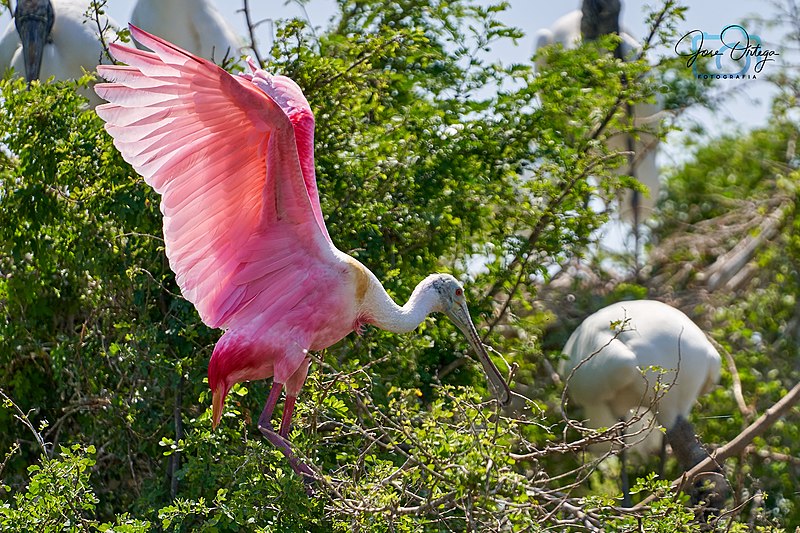
The Roseate Spoonbill is a beautiful and majestic bird found in both North and South America.
It belongs to the ibis family, Threskiornithidae, and its vibrant pink colour comes from canthaxanthin pigment derived from their diet of crustaceans like shrimp.
Sadly plume hunting has almost driven this species close to extinction during the 18th and 19th centuries but fortunately it’s making a comeback due to conservation efforts made by dedicated wildlife organisations.
Its large spoon-like bill helps them filter out food sources such as small fish or frogs from shallow water areas while they wade through mudflats with their long legs looking for something tasty.
With its unique appearance, graceful wingspan amd impressive flight capabilities, the Roseate Spoonbill is an incredibly photogenic animal that will captivate any viewers attention who happen to be lucky enough witness it in all its glory.Scientific classification:
| Kingdom | Animalia |
| Phylum | Chordata |
| Class | Aves |
| Order | Pelecaniformes |
| Family | Threskiornithidae |
| Genus | Platalea |
| Species | P. ajaja |
Also Featured In: Costa Rica Birds, Famous Paintings Birds
15. Snowy Egret
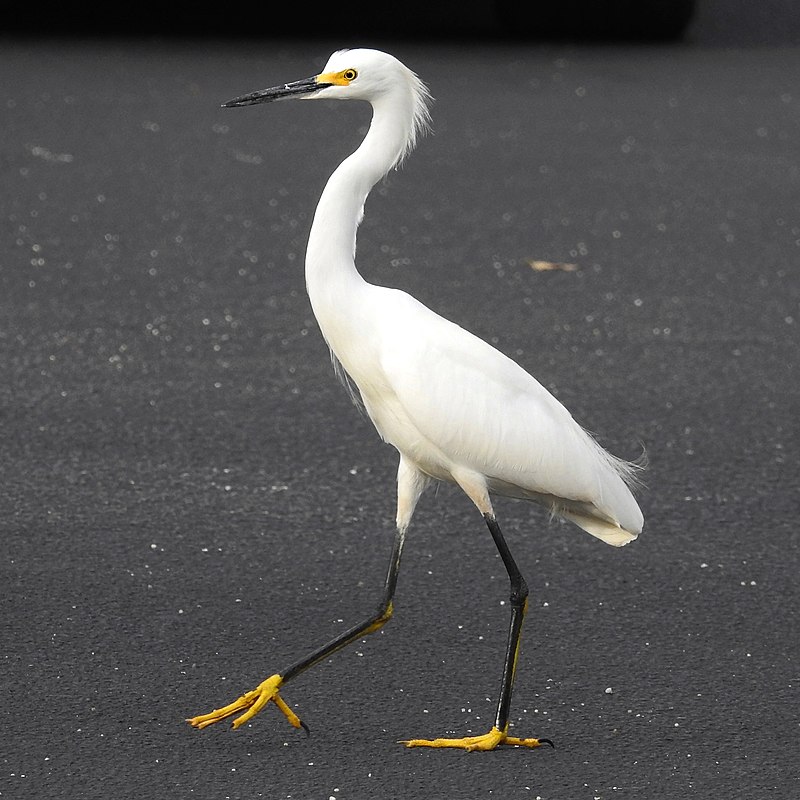
The Snowy Egret is a small white heron native to North America. Its scientific name, Egretta thula, comes from Provençal French for the little egret and an incorrect reference to the Black-necked Swan by Chilean naturalist Juan Ignacio Molina in 1782.
This beautiful bird has black legs with yellow feet, and a long plume of feathers on its head that often appears as if it’s wearing a crown.
It feeds primarily on insects and aquatic life like fish or frogs making it well adapted for both wetland habitats such as marshes or swamps plus coastal areas close to shorelines.
With their graceful movements they are truly delightful creatures to observe while out exploring nature.Scientific classification:
| Kingdom | Animalia |
| Phylum | Chordata |
| Class | Aves |
| Order | Pelecaniformes |
| Family | Ardeidae |
| Genus | Egretta |
| Species | E. thula |
Also Featured In: Trinidad and Tobago birds, Birds that Live in the Deserts
16. Spotted Sandpiper
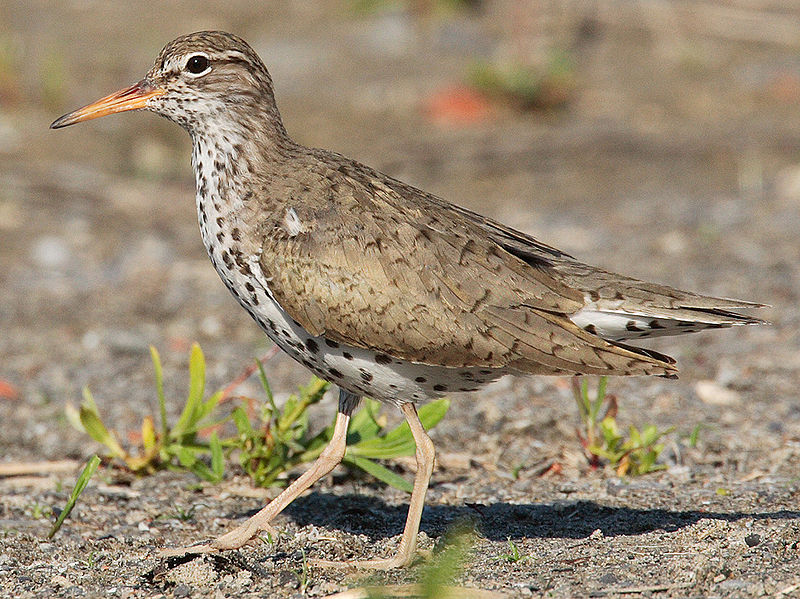
The Spotted sandpiper (Actitis macularius) is a small shorebird that can be found across North America and parts of South America.
It has an appealing spotted plumage, predominately brown in colour with white spots on the wings, tail feathers, head and neck.
The Common Sandpiper (A. hypoleucos) is its sister species which takes over geographically when the other moves away; they have been known to hybridize as well when strays settle down among breeders.
This bird was first described by Carl Linnaeus in 1766 in his twelfth edition of Systema Naturae as a migratory summer visitor to Europe but it now also occupies many habitats too like beaches, riversides and even grasslands during migration periods or for breeding season itself.
Its diet consists mainly of insects such as air-borne flies plus molluscs from shallow water areas – this makes them quite unique amongst waders.Scientific classification:
| Kingdom | Animalia |
| Phylum | Chordata |
| Class | Aves |
| Order | Charadriiformes |
| Family | Scolopacidae |
| Genus | Actitis |
| Species | A. macularius |
Also Featured In: Suriname birds, Common Central Park Birds
17. Redhead
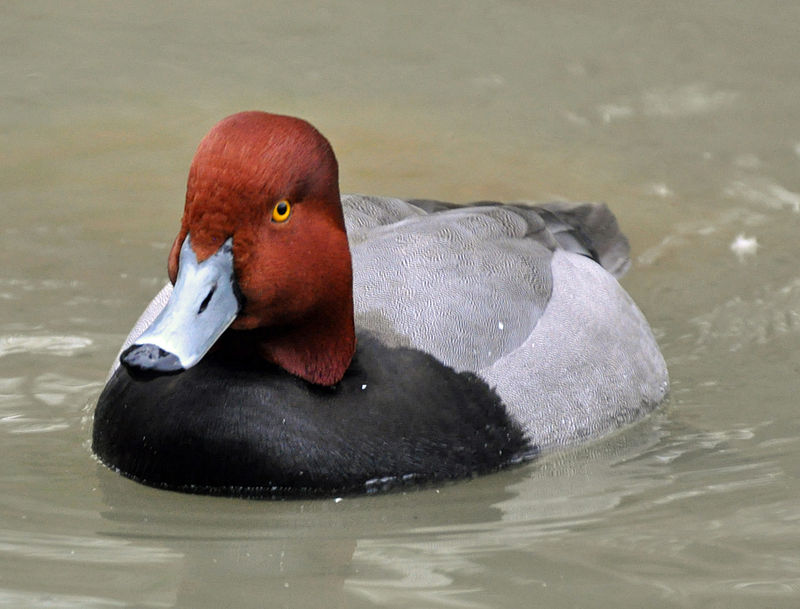
The Redhead is a medium-sized diving duck that can be found in North America. It has a scientific name of Aythya americana, with its Greek roots translating to an unidentified seabird and the Latin meaning “of America”.
This bird measures 37 cm (15 in) long on average with an 84 cm (33 in) wingspan. The typical weight for this species ranges from 2 to 2.5 pounds, although males tend to weigh slightly more than females at around 2.4 lbs (1083 g).
Its beautiful plumage includes shades of browns and grays along with distinctive red feathers on its head which give it its name.
They mainly feed off insects, aquatic plants, small fish and crustaceans making them excellent divers.Scientific classification:
| Kingdom | Animalia |
| Phylum | Chordata |
| Class | Aves |
| Order | Anseriformes |
| Family | Anatidae |
| Genus | Aythya |
| Species | A. americana |
Also Featured In: Bermuda birds, Birds in Pacific Northwest
18. Double-Crested Cormorant

The double-crested cormorant is a majestic bird with an impressive wingspan, found across North America from the Aleutian Islands all the way down to Mexico.
Its black plumage stands out against its bright orange-yellow facial skin and some extended patches of white feathers on each side of its throat.
It measures between 28 – 35 inches in length and has webbed feet that enable it to swim gracefully through rivers and lakes, as well as coastal areas.
These birds are known for their voracious appetite for fish, sometimes diving over 100 ft deep into water looking for food.
Despite this reputation they also feed on crustaceans, amphibians and insects when available.
Cormorants have been part of many cultures throughout history due to their remarkable ability to fly long distances making them valued messengers or companions during fishing expeditions at sea.Scientific classification:
| Kingdom | Animalia |
| Phylum | Chordata |
| Class | Aves |
| Order | Suliformes |
| Family | Phalacrocoracidae |
| Genus | Nannopterum |
| Species | N. auritum |
Also Featured In: Cormorant Species, Water Birds Live around Us
19. Painted Bunting
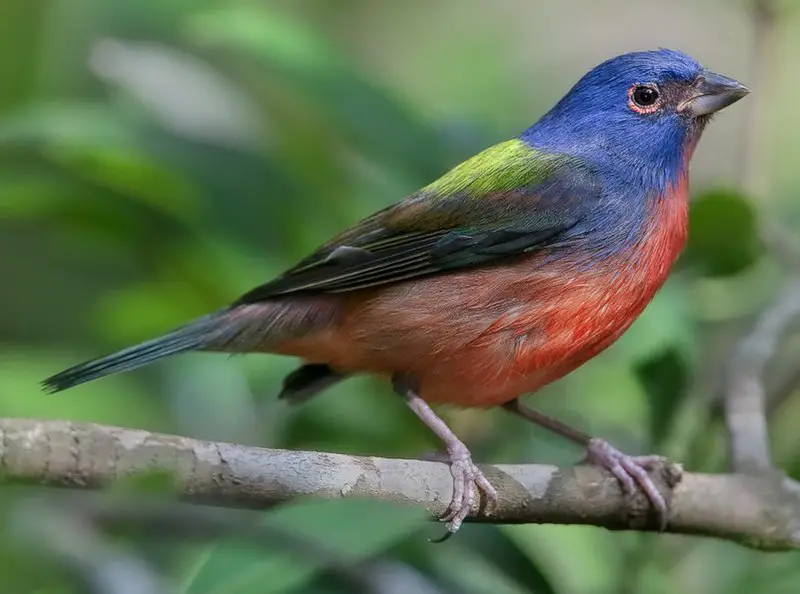
The Painted Bunting is an eye-catching bird from the Cardinal family, native to North America. It was first described by Carl Linnaeus in his eighteenth-century Systema Naturae.
The males of this species are particularly striking; they have brightly coloured plumage which only appears after their second year of life and can be distinguished from female birds through close inspection.
These colourful songbirds are a delight for any avid birder, with their vibrant hues bringing joy to nature lovers everywhere.
They often inhabit woodland areas where there is plenty of seed and insects available for them to feed on – as well as some shrubbery so that they can hide away safely when needed.Scientific classification:
| Kingdom | Animalia |
| Phylum | Chordata |
| Class | Aves |
| Order | Passeriformes |
| Family | Cardinalidae |
| Genus | Passerina |
| Species | P. ciris |
Also Featured In: Texas Birds, Flocks Birds around Us
20. Brown Pelican

The majestic brown pelican is a dive-feeding bird that belongs to the pelican family. It is one of the three pelican species found in the Americas and is known to dive into water to catch its prey.
From the Atlantic Coast of New Jersey to the mouth of the Amazon River, and along the Pacific Coast from British Columbia to northern Chile, including the Galapagos Islands, this bird can be found.
Its scientific name is Pelecanus occidentalis, and it has a colored brown plumage, which is its distinct characteristic.
The brown pelican belongs to the largest bird species that exist today, with a wingspan that can stretch up to seven feet long.
This bird helps maintain a balance in the ecosystem by eating smaller fish, crustaceans, and other aquatic prey.Scientific classification:
| Kingdom | Animalia |
| Phylum | Chordata |
| Class | Aves |
| Order | Pelecaniformes |
| Family | Pelecanidae |
| Genus | Pelecanus |
| Species | P. occidentalis |
Also Featured In: Birds You’ll Find in the Sea, Flight Birds You Should Know
21. Northern Pintail
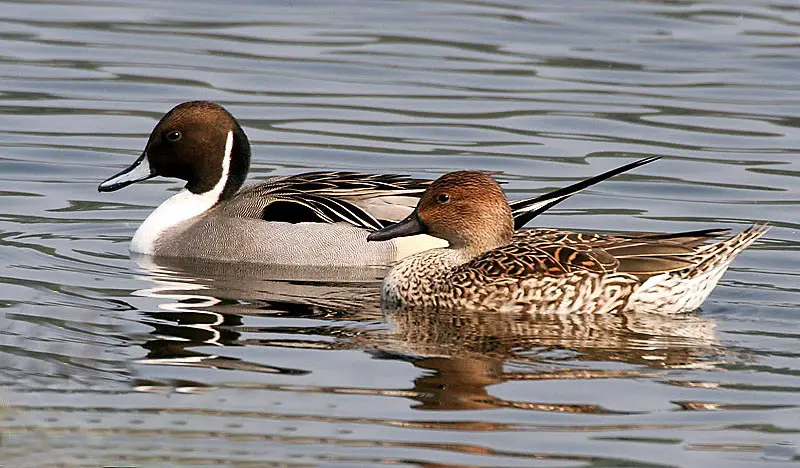
The Northern Pintail is a widespread duck species that breeds in northern parts of Europe, across the Palearctic and North America. This migratory bird winters south of its breeding range to the equator.
Unlike most birds with such a wide range, it does not have any subspecies. The male Northern Pintail has a distinctive long, thin tail and a chocolate-brown head. The female has a mottled brown body and a shorter tail.
This duck species prefers shallow wetlands or marshes for breeding and feeds on aquatic plants and insects.
The Northern Pintail is a highly migratory bird, covering great distances in search of suitable habitats.
Despite some threats, this species is not considered globally threatened, although certain populations are experiencing a decline in numbers.Scientific classification:
| Kingdom | Animalia |
| Phylum | Chordata |
| Class | Aves |
| Order | Anseriformes |
| Family | Anatidae |
| Genus | Anas |
| Species | A. acuta |
Also Featured In: Most Common Lake Birds, British Columbian Birds
22. Tricolored Heron
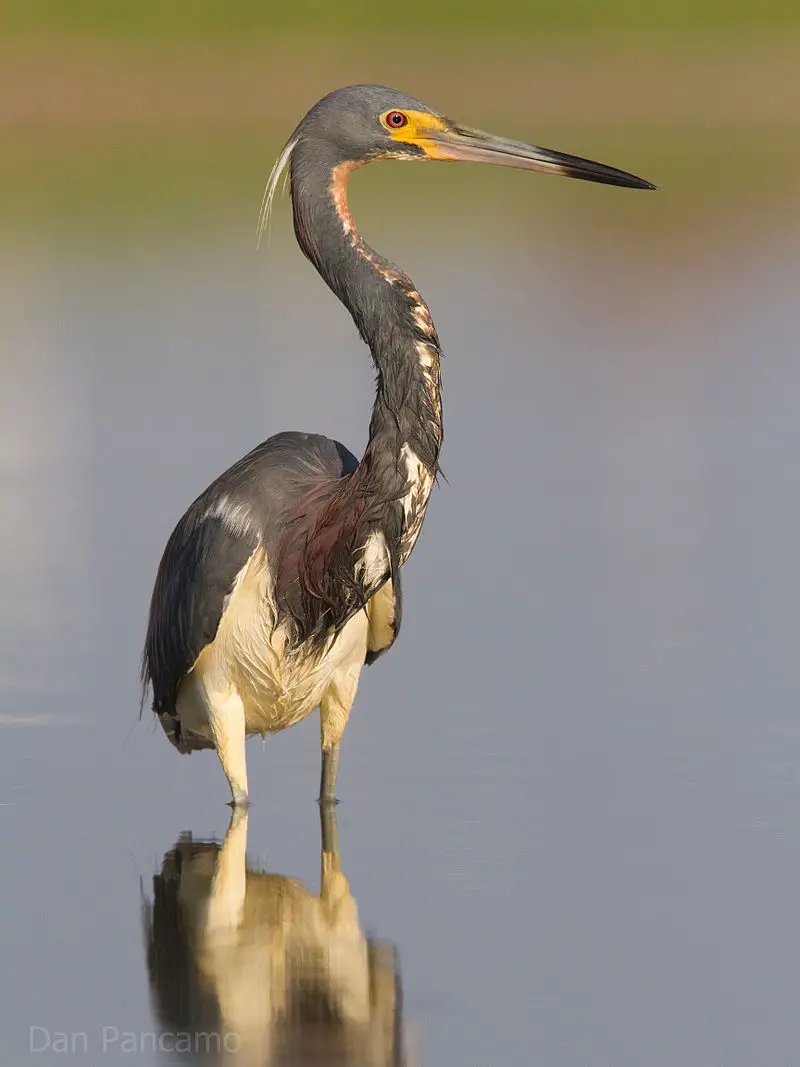
The Tricolored heron, also known as Egretta tricolor, is a species of heron found in coastal areas of the Americas. Unlike other types of herons, the Tricolored heron is more solitary and primarily feeds on small fish.
These birds usually breed in swamps and coastal habitats and tend to build their nests in colonies along with other herons. They typically build their nests on platforms.Scientific classification:
| Kingdom | Animalia |
| Phylum | Chordata |
| Class | Aves |
| Order | Pelecaniformes |
| Family | Ardeidae |
| Genus | Egretta |
| Species | E. tricolor |
Also Featured In: Birds that can be Seen in Outer Banks, Blue Birds that You’ll Find in Utah
23. White-Tailed Hawk
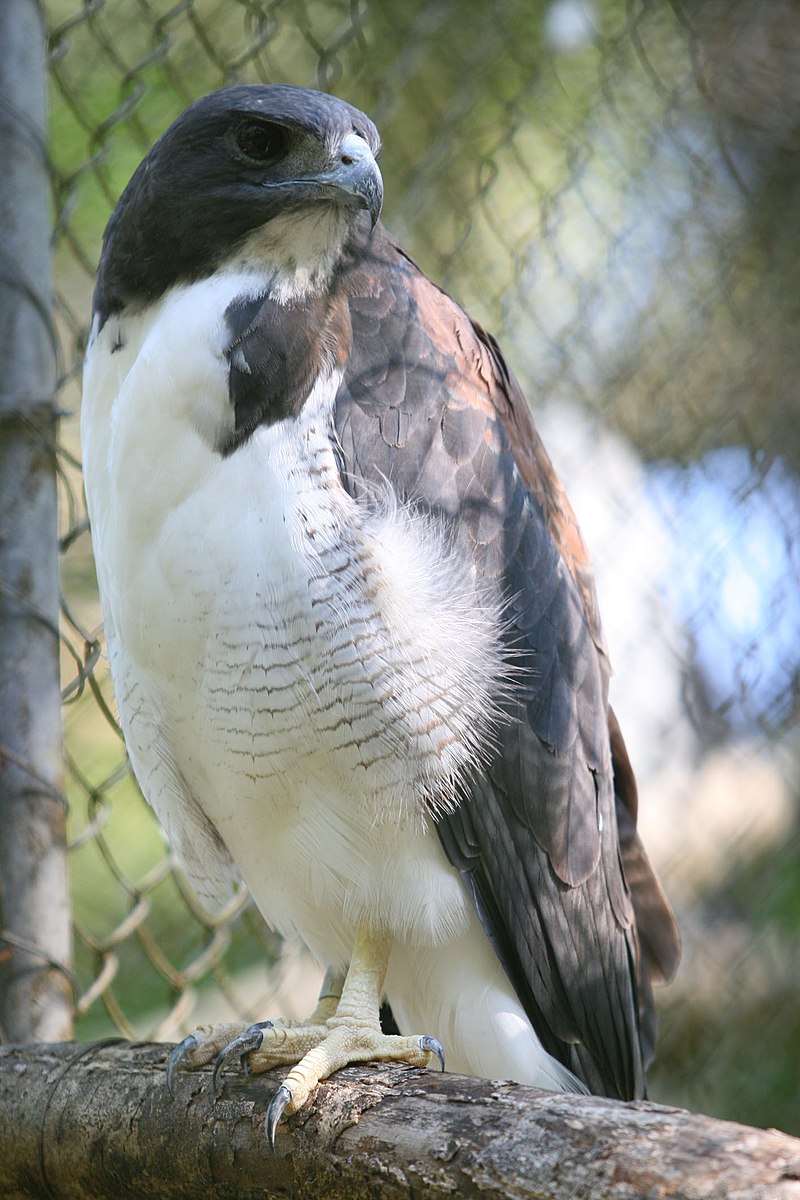
The white-tailed hawk is a robust bird of prey that inhabits tropical and subtropical areas of the Americas. It is similar in size to other hawks like the Swainson’s and red-tailed.
Its measurements are slightly ahead of the former and behind the latter. The white-tailed hawk has a distinct white tail, contrasting with its dark brown back and wings. It feeds on small mammals, reptiles, and birds, and it is known for its impressive hunting skills.
This species is threatened by habitat loss and persecution, as it is seen as a threat to livestock by some farmers. Conservation efforts are being made to protect this magnificent bird and ensure its survival in the wild.Scientific classification:
| Kingdom | Animalia |
| Phylum | Chordata |
| Class | Aves |
| Order | Accipitriformes |
| Family | Accipitridae |
| Genus | Geranoaetus |
| Species | G. albicaudatus |